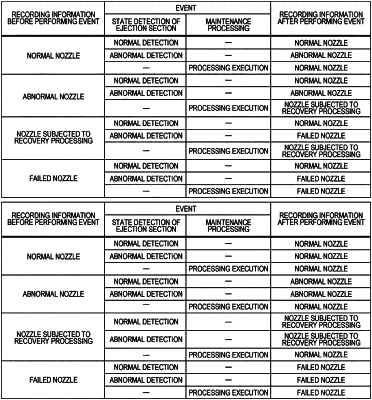| CPC B41J 2/0451 (2013.01) [B41J 2/04563 (2013.01); B41J 2/04581 (2013.01)] | 7 Claims |

|
1. A liquid ejecting apparatus comprising:
an ejection section ejecting a liquid;
a state detection section detecting a state of the ejection section;
a determination section determining whether or not the ejection section has an abnormality based on a detection result of the state detection section;
a recording section recording a determination result of the determination section;
a temperature detection section detecting a temperature of the ejection section; and
a maintenance section executing maintenance processing on the ejection section, wherein
when the recording section records abnormality information indicating the abnormality of the ejection section as the determination result by determining that the abnormality occurred in the ejection section by the determination section, and the temperature detection section detects a temperature that is out of an inspection temperature range in which the state detection section detects the state of the ejection section, the abnormality information recorded in the recording section is reset to a normality information indicating that the ejection section does not have the abnormality if the maintenance section executes the maintenance processing, and
when the recording section records the abnormality information as the determination result by determining that the abnormality occurred in the ejection section by the determination section, and the temperature detection section detects a temperature that is within the inspection temperature range, the abnormality information recorded in the recording section is updated to a recovery information indicating that the ejection section has been recovering from the abnormality if the maintenance section executes the maintenance processing, with the recovery information being different from the normality information.
|